Cuarenta uses a Spanish 40 deck which can be formed from a standard deck by removing all eights, nines and tens from that deck. The ranking of the cards in the deck used for this game is as follows (from high to low); King, Queen, Jack, 7, 6, 5, 4, 3, 2, Ace.
Determination of the first dealer in this game is usually performed by either player picking up the shuffled deck and beginning to deal out cards to the players one by one, starting with his opponent. Whichever player receives the first card in the suit of diamonds becomes the first dealer.
Once the dealer has been determined, he thoroughly shuffles and offers the deck to his opponent to cut. After the cut, the dealer then deals five cards to each player, in one five card packet, starting with his opponent. After dealing the cards, the dealer places the remainder of the deck face-down in the center of the table to form the stock.
After the deal, both players then have the opportunity to make an announcement. If either player has a Double Ronda (four cards of the same rank), he instantly wins the current game. In the extremely rare case in which both players have a Double Ronda, the player with the higher ranking four of a kind wins the game. If neither player has a Double Ronda, the players may announce a standard Ronda. The player simply announces that he has a Ronda but does not specify the rank of the cards that comprise it. A Ronda earns a player four points immediately.
After any announcements are made, play of the hand begins, starting with the dealers opponent. Each turn consists of a player placing one card from his hand face-up near the center of the table. If there are any applicable captures, the player may make the capture, adding them to a face-down pile of captured cards which are set aside, out of play. The following shows the type of captures that may be made during the hand:
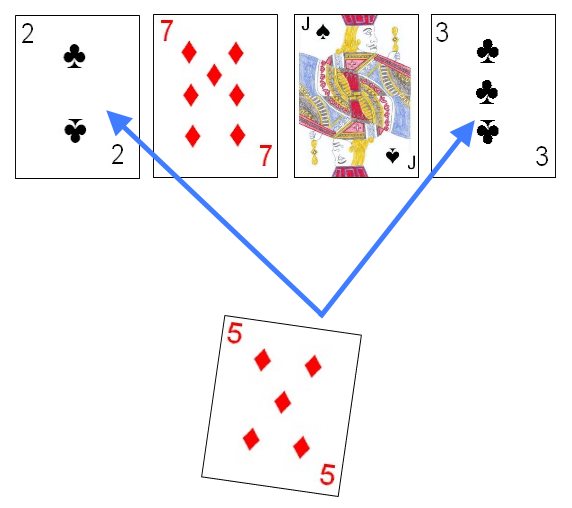
- Matched Card: If the card played is of the exact same rank as another such card on the table, the player may take both cards and add them to his capture pile. The player may only capture one other card in this method, so if there are two or more cards of that same rank on the table, the player may only capture one of these cards.
- Addition: If the player on his turn, plays a card in which two or more cards currently on the table sum to, the player may capture his played card as well as the cards which sum to that total. The additive value of the cards for this purpose are as follows; Ace =1, 2 to 7 the value marked on the card, Kings, Queens and Jacks have no specific value and thus cannot be captured through an addition capture.
- Sequence: If a player is able to make a capture through either a Matched Card or Addition, he may also capture certain Sequences of cards found on the table. Thus, if any other cards currently on the table is in direct sequence with the card played, the player may also take those cards. For example, if the player plays a 4 and captures another four, and a 5, 6, and 7 are also on the table he may take these cards as well. Sequences may not go around the corner, so the highest possible card in any sequence could be a King. It should also be noted for players more familiar with the standard deck, the special ranking of the cards in the Spanish deck as noted above.
If a player is able to, on his own turn, capture the card played immediately prior by his opponent by matching it with a card of the same denomination, he is said to have earned a Caida. The player making the Caida earns two bonus points. If a player makes a Caida that was part of his opponents Ronda (and remembers and states this fact before the next deal), he scores a bonus of 10 points.
If a player manages to clear the table by capturing all the cards on the table during his turn, he scores for a Limpia. Doing so enables that player to score two bonus points. A player may not score for a Limpia if there has been any intervening turns between the plays, or if any cards have been dealt from the deck (due to the players depleting their hands).
Once both players have played all five card in their hands, the dealer deals five more cards to each player from the stock (starting with his opponent).
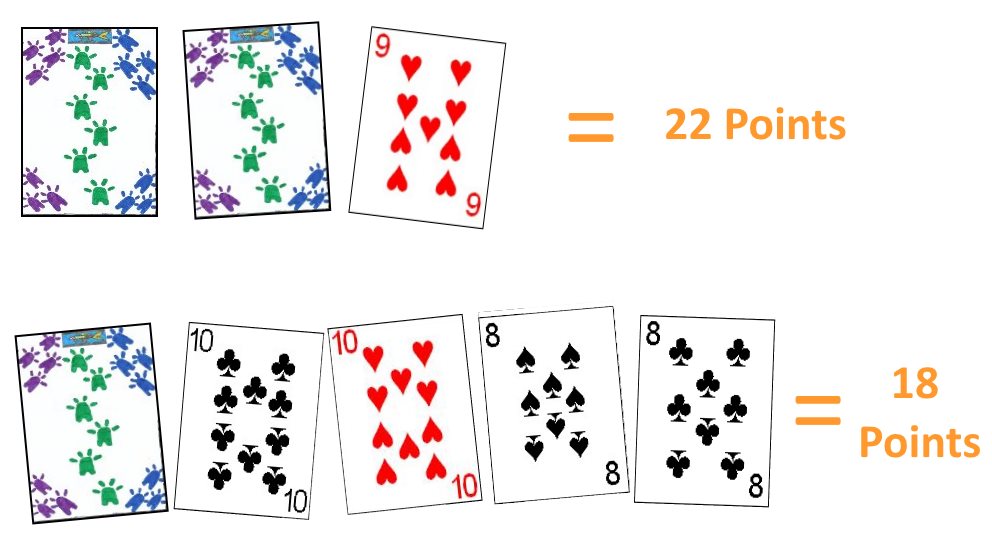 Once all the cards have been depleted from the stock and the players play the last five cards in their hand, the hand ends. The players each count the cards they managed to capture during the hand. If a player manages to capture exactly 20 cards he earns 6 points. If he manages to capture over 20 cards, the player earns 6 points plus one point for each card captured over 20 (rounded upward to the next even number). If both players manage to capture exactly 20 cards, the non-dealing team scores 6 points but the dealer does not. If neither player captures 20 or more cards, the player which captured more cards scores 2 points. If both players tie, capturing fewer than 20 cards, the non-dealing team scores 2 points.
Once all the cards have been depleted from the stock and the players play the last five cards in their hand, the hand ends. The players each count the cards they managed to capture during the hand. If a player manages to capture exactly 20 cards he earns 6 points. If he manages to capture over 20 cards, the player earns 6 points plus one point for each card captured over 20 (rounded upward to the next even number). If both players manage to capture exactly 20 cards, the non-dealing team scores 6 points but the dealer does not. If neither player captures 20 or more cards, the player which captured more cards scores 2 points. If both players tie, capturing fewer than 20 cards, the non-dealing team scores 2 points.
Recording the Score: Although other methods can be used to record the player's scores during the hand (such as with a pencil and a scoresheet), the traditional method is to record each player's score with the unused cards removed from the standard deck. When using this method of recording the scores, all the eights, nines and tens removed from the standard deck are set aside to be used to indicate a player's current score at any time during the game. These cards each represent a number of points. One of these cards displayed face-up by the player represents 2 points. When a player collects 5 such cards (10 points) he returns these five cards, replacing them with one of these cards displayed face-down (which represents 10 points). In order to ensure there are enough of these extra cards, when a player has exactly 38 points (just two points from winning the game) he returns all of his scorekeeping cards, indicating that the next time he earns any score he will win the hand. A player who has not yet scored any points will also not possess any cards, but this will usually only be the case near the beginning of the game. Alternatively, some player prefer to keep score using matchsticks or straws. Each time the player earns two points, he would take one stick, representing two earned points.
Four Player Cuarenta: Cuarenta can also be played by four players, consisting of two partnerships of two players each. The rules are identical to the standard two-player variant, with the following differences:
- Determination of the partnerships should be done similarly to the method of determining the first dealer in the standard version. Any player begins dealing and the first two players to receive a card in the suit of diamonds become partners against the other two players. The player receiving the first card of the diamond suit becomes the first dealer. Each player should sit directly across the table from his partner.
- The dealer begins dealing starting with the player to his immediate left and continuing in a clockwise direction around the table. The rotation of the deal between hands also rotates around the table in a clockwise direction.
- The player to the dealer's immediate left has the first turn, with the turn rotating in a clockwise direction around the table.
- At the end of the hand, the cards captured by both players in the partnership are combined to determine points that should be scored for captured cards.
- In each partnership one player usually takes in all captured cards for the partnership and his opponent keeps a combined score for the partnership.
Copyright © 2015 CatsAtCards.com. All rights reserved.
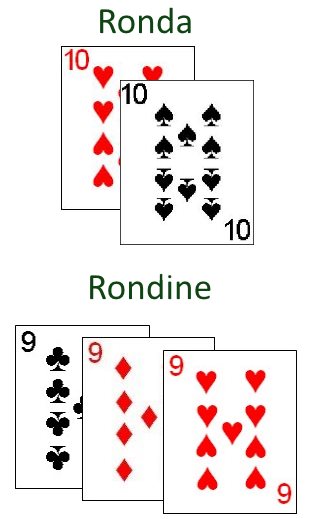
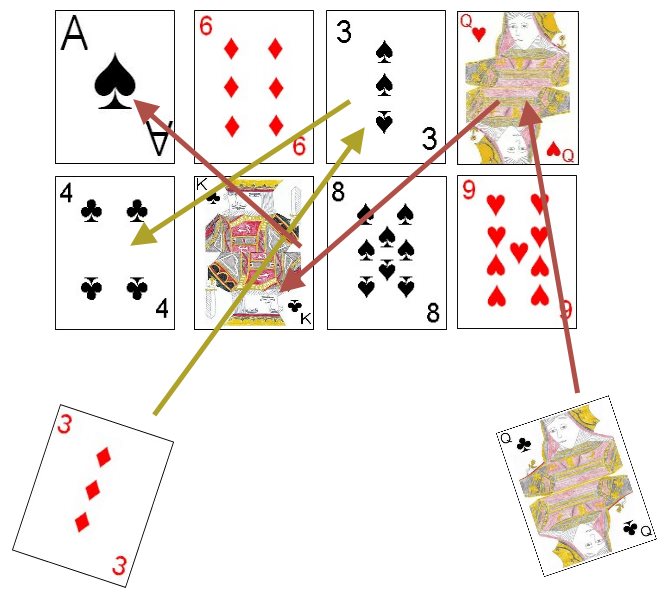 After these declarations, play of the hand begins. The player to the immediate left of the dealer has the first turn, with the turn proceeding in a clockwise rotation around the table.
After these declarations, play of the hand begins. The player to the immediate left of the dealer has the first turn, with the turn proceeding in a clockwise rotation around the table.
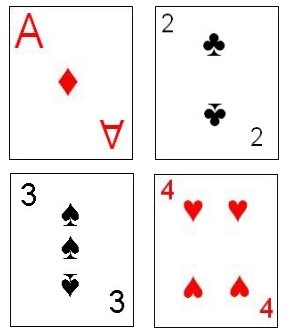 Tendido: Another unique feature of this game is the concept of the Tendido. Once per hand, the current dealer is permitted to deal out four extra cards to the center of the table. He does this any time after dealing the three cards to each player (either on the first deal of the hand or any time he replenishes the player's hands). The Tendido consists of the dealer dealing a special layout to the center of the table. This consists of four cards in two horizontal rows consisting of two cards each, face up from the deck. He may not look at the cards before dealing to the layout. The dealer can earn special bonus points based on certain cards which make up the Tendido. The dealer may swap the cards in a horizontal row in the Tendido but may not
switch cards between the two rows. If, any card dealt is found in the correct positional layout in the Tendido, the dealer earns a number of points equal to the value marked on the card. Thus, if an Ace is found in the first position, a two in the second position, a three in the third position, or a four in the fourth and last position of the Tendido, the dealer would score from 1 to 4 points respectively. In addition,
if the cards dealt to the Tendido contain four of a kind, three of a kind, or a pair, the dealer also scores points as shown on the following chart:
Tendido: Another unique feature of this game is the concept of the Tendido. Once per hand, the current dealer is permitted to deal out four extra cards to the center of the table. He does this any time after dealing the three cards to each player (either on the first deal of the hand or any time he replenishes the player's hands). The Tendido consists of the dealer dealing a special layout to the center of the table. This consists of four cards in two horizontal rows consisting of two cards each, face up from the deck. He may not look at the cards before dealing to the layout. The dealer can earn special bonus points based on certain cards which make up the Tendido. The dealer may swap the cards in a horizontal row in the Tendido but may not
switch cards between the two rows. If, any card dealt is found in the correct positional layout in the Tendido, the dealer earns a number of points equal to the value marked on the card. Thus, if an Ace is found in the first position, a two in the second position, a three in the third position, or a four in the fourth and last position of the Tendido, the dealer would score from 1 to 4 points respectively. In addition,
if the cards dealt to the Tendido contain four of a kind, three of a kind, or a pair, the dealer also scores points as shown on the following chart: